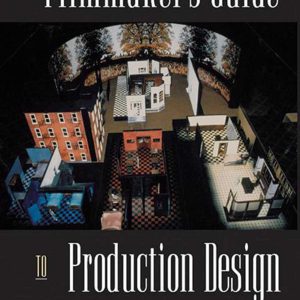Directing: Film Techniques and Aesthetics is a comprehensive exploration into the art and craft of directing for film and television. It’s filled with practical advice, essential technical information, and inspiring case studies for every stage of production. This book covers the methods, technologies, thought processes, and judgments that a director must use throughout the fascinating process of making a film, and concentrates on developing the human aspects of cinema to connect with audiences.
The fully revised and updated 6th edition features new sections on using improvisation, the development of characters for long form television series, visual design, the role of the digital imaging technician, film promotion and distribution, alongside expanded information on contemporary color grading tools, stylistic approaches and genre, workflows, blocking scenes for the camera and more. The book emphasizes independent and short form cinema which allows cutting-edge creativity and professionalism on shoestring budgets. Recognizing that you learn best by doing, it includes dozens of practical hands-on projects and activities to help you master technical and conceptual skills.
Just as important as surmounting technological hurdles is the conceptual and authorial side of filmmaking. This book provides an unusually clear view of the artistic process, particularly in working with actors and principle crew members. It offers eminently practical tools and exercises to help you develop your artistic identity, find credible and compelling stories, choose and work with your cast and hone your narrative skills. Directing shows you how to surpass mere technical proficiency and become a storyteller with a distinctive voice and style.
The accompanying companion website includes film analysis exercises, shooting projects, checklists and assignment forms, analytical questionnaires, updated production forms and logs for all phases of a project with links to additional resources and set safety advice.













Hamilton Beck –
“Making Movies” is one of the best books on the nuts and bolts of film-making ever. It deserves the highest rating simply because it is both well presented and full of practical insights. Lumet is brilliant on the psychology of movie-making in the old days, for instance, when each producer had the power to order cuts at will. The director who knew this would deliberately leave some weak scenes in during early screenings so that the producers could order them removed and thus later claim to have “saved” the picture – if, that is, it turned out to be a hit. That said, Lumet’s overall approach is not historical but topical, from selecting a writer to making the final cut. In Chapter Three, he raises a point I often try to impress upon my students: The way you tell a story should relate somehow to what that story is about. That gets to the whole question of the importance of style, which he terms “the most misused word since love.” (pg. 49) Good, practical advice can be found on every page. Here’s how he can tell if something is off when watching a scene during rushes: “If my concentration breaks, something is wrong.” (pg. 141) This, I might add, applies equally well to reading as to watching – if our attention drifts, there may be something wrong with the book we are reading, or the text of the speech we are delivering. Here’s something that may seem counter-intuitive: The audience’s perception of the length of a film depends not on the tempo of the movie itself so much as the presence or absence of changes in tempo. The fewer the changes, even if the tempo is fast, the longer the movie will seem. Most melodramas accelerate speed towards the end. Inexperienced directors adopt an up-tempo from the start, then believe they have left themselves nowhere to go except even faster, thus exhausting the audience long before the final credits. Lumet candidly confesses he doesn’t know what makes a hit, and doubts that anyone really does. It is certainly not the stars alone. He talks about those he has worked with (including Paul Newman and Al Pacino) without indulging in gossip, and when he has something negative to say, he does so without naming names. One movie of his, which he refuses to identify, suffered from the limited range of one of its stars. “On the second day of shooting, I began to realize that the leading actress lacked the tenderness her part called for. She simply didn’t have it in her as an actress or a person. She was superb with anger; she had humor. But if she was asked to show the simplest affection for the person playing opposite her, a falseness crept into her acting that was readily apparent, particularly since her acting was otherwise so real and true…. Since the movie was fundamentally a love story, I knew that we were in trouble.” (pp. 143-144) I wonder if the movie in question might not have been “The Morning After.” The only hint he provides is that the film “had three very high-powered stars in it.” “Morning After” featured Jane Fonda, Jeff Bridges and Raul Julia. On the other hand, Fonda did receive an Oscar nomination for her performance here, so I can’t be certain. Though most (but not all) of the examples are taken from movies he himself directed, the book is most definitely not a survey of his career. While “Murder on the Orient Express,” for example, gets mentioned at least a dozen times, “Fail Safe” rates only a single one, early on. Incidentally, what he has to say about “Murder…” gives me a higher opinion of that movie than I ever had before; now I am tempted go back and take another look at it. The chapter on the “lens plot” in “12 Angry Men” – how he used differing lenses to create an increasing sense of claustrophobia – is justly famous. On the whole, Making Movies is an enlightening introduction to the craft, presented by an insider. If you are like me, you will be amazed at what you hadn’t noticed in movies you thought you knew.For a longer version of this review, please go to hamiltonbeck dot wordpress dot com
F. Felix –
As has been abundantly stated by other reviewers, this is an interesting book for both movie lovers & movie makers. It is eminently readable, in a flowing, non-technical style that is surprisingly effective at delivering practical information about Lumet’s filmmaking choices & philosophy through the decades of a legendary career.Many how-to manuals seem to put the cart before the horse. Refreshingly, rather than providing instruction in equipment-driven decision making [here’s how you use this particular lens, camera, fill light, etc.], Lumet talks about his story-telling goals then how he worked with his team to identify the proper technology to achieve them, resulting in such stylistically varied successes as the hyper-real video & dialog quality of “Dog Day Afternoon” & the Rembrandt-esque look of “The Verdict”.This book has a fly-on-the-wall quality that almost makes you feel like you are participating in a long dinner conversation where the filmmaker discusses his day, reliving his experiences, revisiting his ideas & choices, evaluating whether they worked or not, even racking on the unprofessional Teamster who made him late to rehearsal, then pillaged the craft services cart.Something that hasn’t been stated by other reviewers is how remarkably humble the author comes off. Far from validating the “auteur” status that many would grant him, Lumet appears to have a sincere appreciation for the complex team effort that results in a major motion picture, rather than an inflated perception of the supremacy of the director’s role. He is extremely knowledgeable about all aspects of the filmmaking process & manages to share that knowledge clearly & concisely. He has profound respect for the contributions of the players who typically get nothing but abuse: the studio execs, writers, post-production, the stars.Lumet even seems honestly enraptured by the emergent qualities that blossom from a group effort where “everyone is making the same movie”, & he takes his responsibilities for vision, coordination & budgeting very seriously.This guy just comes off as the consummate professional & his book is a joy to read.
Jordan Hunter –
Sidney Lumet’s “Making Movies” is a wonderful insight into the director’s role in the filmmaking process. The entire book reads like Lumet has sat you down to tell you a story. We get a chance to peer into his mind as he makes small but critical choices throughout the Pre-Production, Production, and Post-Production phases in the movie’s life. Lumet gives many clear and specific examples of moments in his career where he had to overcome the odds to get the shot or performance that the film called for. This book is great for the aspiring filmmaker and seasoned industry veteran alike.I knocked off 1 star only because some of the technical processes of filmmaking described in the book are no longer used, and it made the book feel very dated. The writing is still great and it’s nice to hear about how films used to be made. The techniques of working with actors still hold up, as well as the detailed descriptions of the director’s role within the larger company of talent and executives.I highly recommend this book to anyone who wants to advance their cinema education and gain deep appreciation for the art form.
John –
I received Making Movies at around noon today, and am writing this a bit after six PM, having finished the entire book. Lumet was a man who loved movies, loved working on movies, and it shows in every word. He takes the reader through every stage of making a movie – pre to shooting to post and then some. Utterly captivating for a small-time filmmaker like myself, but even if you’re just a fan, there is much to learn and be entertained by here. Highly recommended for anyone even remotely involved in filmmaking, and also recommended to anyone who wants to learn more about the tremendous work, passion, and resolve it takes to make a movie.
Alan Camarena –
El mejor empaquetado que he visto para libros
Llegó en excelentes condiciones, súper bien empaquetado para evitar mojarse por la lluvia.
Lillian Lim – Amazon Customer –
Best book I’ve read so far on directing films
This is, by far, one of the best books I’ve read on directing films. It contains a LOT of fundamental information on directing movies and is very enjoyable reading. Don’t waste your money (and time) on David Mamet’s “On Directing Film” which basically is just a copy of his notes from lectures he’s given to a class and doesn’t contain any RELEVANT information on directing. I threw Mamet’s book into the garbage can after I finished it.
Placeholder –
A great read
A personal guide for anyone interested in the world of making movies
Uhu Buhu –
Still worth reading
Sydney Lumet has produced a book still worth reading after the film industry underwent more fundamental changes. Lumet‘s book covers the mostly pre-digital era that has gone but still contains so many truths about acting, directing and movie making that younger generations still can benefit from.
X-Reyes –
Master Piece!
Da leggere